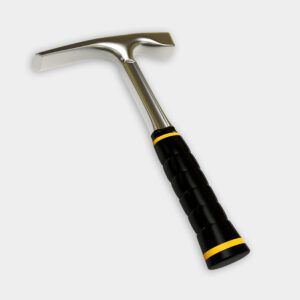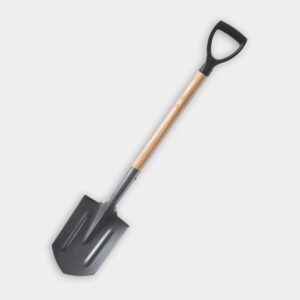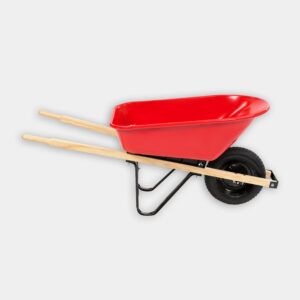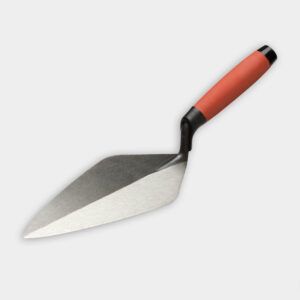We may be compensated if you purchase through links on our website. Our team is committed to delivering honest, objective, and independent reviews on home products and services.
Project details
Skill
Cost
Estimated Time
Upgrading your driveway with cobblestone edging can significantly enhance its functionality and curb appeal. This durable border not only adds a touch of elegance but also helps prevent gravel from washing away during heavy rains.
In this article, we’ll show you how to install cobblestone driveway edging, drawing insights from This Old House mason Mark McCullough. In the video above, McCullough demonstrates the installation process alongside homeowner Erica, addressing drainage issues and elevating the driveway’s appearance.
*Cost information in this article is sourced from estimates used by HomeGuide.
Understanding Cobblestone Driveway Edging
Cobblestone driveway edging serves as a robust barrier between your driveway and the surrounding landscape. It enhances the visual appeal of your property and provides practical benefits. Let’s explore the advantages and considerations of this landscaping feature.
Benefits of Cobblestone Edging
Cobblestone edging offers several advantages for your driveway:
- Enhanced aesthetics: Cobblestones’ natural, timeless look adds character and charm to your property.
- Improved drainage: Properly installed cobblestone edging helps direct water away from your driveway, preventing erosion and water damage.
- Increased durability: Cobblestones are known for their longevity and ability to withstand harsh weather conditions.
- Versatility: These stones can be arranged in various patterns to complement your home’s architectural style.
Considerations Before Installation
Before embarking on your cobblestone edging project, consider the following factors:
- Budget: Cobblestone edging can be more expensive than other options, but its durability often makes it a worthwhile investment.
- DIY vs. professional installation: While it’s possible to install cobblestone edging yourself, hiring a professional may be advisable for larger or more complex projects.
- Driveway material: The type of driveway you have (gravel, asphalt, or concrete) may influence the installation process.
- Local climate: Ensure the materials you choose can withstand your area’s weather patterns.
Preparing for Installation of the Cobblestone Driveway Edging
Proper preparation is crucial for a successful cobblestone driveway edging project. This phase involves gathering the necessary materials and tools, as well as preparing the installation site.
Materials and Tools Needed
To install cobblestone driveway edging, you’ll need the following materials and tools.
Materials
- Cobblestones
- Concrete mix
- Crushed stone or gravel
- Rebar
- Tie wire
Tools
- Masonry trowels
- Mason’s hammer or small pickaxe
- Small sledgehammer or heavy mallet
- Spade shovel
- Tamp
- Wheelbarrow
- Wire twister
Site Preparation
Proper site preparation lays the groundwork for a sturdy cobblestone driveway edging.
Here’s how to do it:
- Remove any existing edging from the driveway using a mason’s hammer or pickaxe.
- Dig a trench along the driveway edge. The trench should be two to three times wider than the cobblestones and approximately 8 inches deep.
- Use a tamp to compact the soil in the trench, creating a solid foundation for the edging.
Installation Process of Cobblestone Driveway Edging
Installing cobblestone driveway edging involves several steps, from laying the foundation to setting the stones. Follow the steps below for a professional-looking result.
Create the Foundation
Lay the foundation for your edging with the following steps:
- Place a 2 to 3-inch layer of gravel or crushed stone in the trench and tamp it down firmly.
- Mix the concrete in a wheelbarrow, adding water gradually until it reaches an oatmeal-like consistency.
- Pour a 2 to 3-inch layer of concrete into the trench to create a solid base for the cobblestones.
Set the Cobblestones
Setting the cobblestones is crucial in this installation process to ensure they are properly aligned and secured.
Take these steps:
- Place the cobblestones in the trench, standing them upright. Use a sledgehammer or mallet to tap them into place, ensuring a tight fit in the concrete.
- Leave about half of each stone above grade for a visually appealing result.
- For areas where you might need wheelbarrow access, lay the cobblestones flat instead of upright.
Reinforce the Edging
Here’s how to ensure the longevity and stability of your cobblestone edging:
- Lay rebar behind the concrete, overlapping each bar by about one foot.
- Use tie wire and a wire twister to connect the rods securely.
- Pour additional concrete on top of the rebar, creating a slope that drains away from the driveway.
McCullough emphasizes the importance of proper drainage, demonstrating how to create a sloped concrete backing for the cobblestones.
Finishing Touches on Your Cobblestone Driveway Edging Project
The final steps in your cobblestone driveway edging project involve filling gaps and allowing time for the installation to set properly.
Filling Gaps and Settling
Once the cobblestones are set, make the following finishing touches:
- Place gravel along the front of the cobblestones and rake it into the cracks.
- Allow the concrete to dry completely before using the driveway. Depending on weather conditions, this typically takes 24 to 48 hours.
Additional Tips for Cobblestone Installation
Undertaking a cobblestone installation can be intensive.
Here are a few extra pointers to ensure a smooth process:
- Conduct levelness checks: Regularly use a level to make sure your cobblestones are even and avoid creating potential trip hazards.
- Install during good weather: Avoid undertaking the project during rainy days or extreme heat, as these conditions can affect how the concrete sets and undermine the overall stability of the cobblestone arrangement.
- Work in sections: Divide your driveway into manageable sections so the concrete doesn’t set before you can adjust the cobblestones.
Common Mistakes To Avoid When Installing Cobblestone
Successfully installing cobblestone driveway edging requires attention to detail.
Be mindful of the following common slip-ups:
- Inadequate trench depth: Failing to dig a trench deep enough can result in an unstable foundation. Confirm the trench is at least 8 inches deep to accommodate the base materials and cobblestones.
- Insufficient compaction: Ensure the gravel or crushed stone base is well-compacted before installing the cobblestones. A poorly compacted base can lead to settling and uneven edging.
- Skipping rebar and concrete reinforcement: Omitting rebar and additional concrete reinforcement can compromise the durability of your cobblestone edging. This step is crucial for ensuring long-term stability.
Cobblestone Maintenance Tips
To keep your cobblestone driveway edging looking great and functioning properly, keep these tips in mind:
- Clean the edging periodically to remove dirt and debris.
- Reapply gravel between stones as necessary to maintain proper drainage.
- Regularly inspect for any loose stones and reset them as needed.
Resources
McCullough works alongside a homeowner to raise the sinking driveway edging. Ideally, the red brick edging acts as a barrier and helps to maintain the gravel driveway, but over time, grass or moss can grow over the edging, allowing water and gravity to pull the loose gravel over the edging.
Mark’s Pro Tip: Leave the space between cobblestones unfilled. By doing so, water can pass through the spaces without disturbing the material. If the spaces are filled with concrete, the moisture will work its way in and expand over time until it cracks.
Cobblestones were provided by Cavicchio Greenhouses, Inc.






